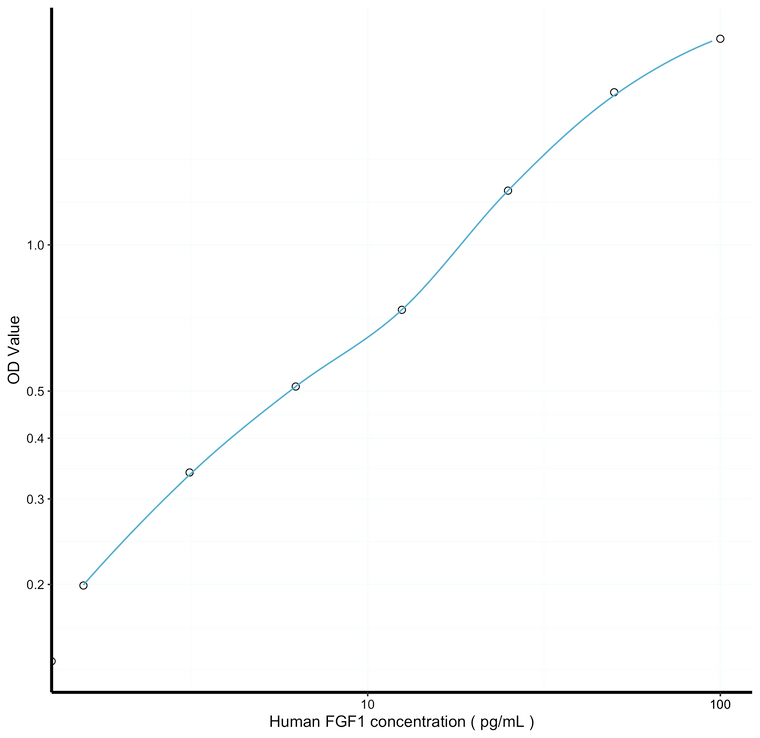| Applications: |
ELISA |
| Reactivity: |
Human |
| Note: |
STRICTLY FOR FURTHER SCIENTIFIC RESEARCH USE ONLY (RUO). MUST NOT TO BE USED IN DIAGNOSTIC OR THERAPEUTIC APPLICATIONS. |
| Sensitivity: |
0.61pg/mL |
| Detection Limit: |
1.56-100pg/mL |
| Short Description: |
This FGF1 Sandwich ELISA Kit, Ready-To-Use is an in-vitro enzyme-linked immunosorbent assay for the measurement of samples in human cell culture supernatant, serum and plasma (EDTA, citrate, heparin). |
| Storage Instruction: |
Store the unopened kit in the fridge at 2-8°C for up to 6 months. Once opened store individual kit contents according to components table provided with the kit. |
| Assay Time: |
3 hrs |
| Gene Symbol: |
FGF1 |
| Gene ID: |
2246 |
| Uniprot ID: |
FGF1_HUMAN |
| Immunogen Region: |
Ready-To-Use |
| Sample Type: |
serum, plasma, tissue homogenates, cell lysates, cell culture supernates or other biological fluids. |
| Tissue Specificity | Predominantly expressed in kidney and brain. Detected at much lower levels in heart and skeletal muscle. |
| Post Translational Modifications | In the nucleus, phosphorylated by PKC/PRKCD. |
| Function | Plays an important role in the regulation of cell survival, cell division, angiogenesis, cell differentiation and cell migration. Functions as potent mitogen in vitro. Acts as a ligand for FGFR1 and integrins. Binds to FGFR1 in the presence of heparin leading to FGFR1 dimerization and activation via sequential autophosphorylation on tyrosine residues which act as docking sites for interacting proteins, leading to the activation of several signaling cascades. Binds to integrin ITGAV:ITGB3. Its binding to integrin, subsequent ternary complex formation with integrin and FGFR1, and the recruitment of PTPN11 to the complex are essential for FGF1 signaling. Induces the phosphorylation and activation of FGFR1, FRS2, MAPK3/ERK1, MAPK1/ERK2 and AKT1. Can induce angiogenesis. |
| Protein Name | Fibroblast Growth Factor 1Fgf-1Acidic Fibroblast Growth FactorAfgfEndothelial Cell Growth FactorEcgfHeparin-Binding Growth Factor 1Hbgf-1 |
| Database Links | Reactome: R-HSA-109704Reactome: R-HSA-1257604Reactome: R-HSA-1839122Reactome: R-HSA-1839130Reactome: R-HSA-190322Reactome: R-HSA-190370Reactome: R-HSA-190371Reactome: R-HSA-190372Reactome: R-HSA-190373Reactome: R-HSA-190375Reactome: R-HSA-190377Reactome: R-HSA-2033519Reactome: R-HSA-2219530Reactome: R-HSA-5654219Reactome: R-HSA-5654221Reactome: R-HSA-5654227Reactome: R-HSA-5654228Reactome: R-HSA-5654687Reactome: R-HSA-5654688Reactome: R-HSA-5654689Reactome: R-HSA-5654693Reactome: R-HSA-5654695Reactome: R-HSA-5654699Reactome: R-HSA-5654700Reactome: R-HSA-5654704Reactome: R-HSA-5654706Reactome: R-HSA-5654710Reactome: R-HSA-5654712Reactome: R-HSA-5654719Reactome: R-HSA-5654720Reactome: R-HSA-5654726Reactome: R-HSA-5654727Reactome: R-HSA-5654732Reactome: R-HSA-5654733Reactome: R-HSA-5655253Reactome: R-HSA-5655302Reactome: R-HSA-5655332Reactome: R-HSA-5673001Reactome: R-HSA-6811558Reactome: R-HSA-8851708 |
| Cellular Localisation | SecretedCytoplasmCell CortexCytosolNucleusLacks A Cleavable Signal SequenceWithin The CytoplasmIt Is Transported To The Cell Membrane And Then Secreted By A Non-Classical Pathway That Requires Cu(2+) Ions And S100a13Secreted In A Complex With Syt1Binding Of Exogenous Fgf1 To Fgfr Facilitates Endocytosis Followed By Translocation Of Fgf1 Across Endosomal Membrane Into The CytosolNuclear Import From The Cytosol Requires The Classical Nuclear Import MachineryInvolving Proteins Kpna1 And Kpnb1As Well As Lrrc59 |
| Alternative ELISA Names | Fibroblast Growth Factor 1 ELISA kitFgf-1 ELISA kitAcidic Fibroblast Growth Factor ELISA kitAfgf ELISA kitEndothelial Cell Growth Factor ELISA kitEcgf ELISA kitHeparin-Binding Growth Factor 1 ELISA kitHbgf-1 ELISA kitFGF1 ELISA kitFGFA ELISA kit |
| output | |
Information sourced from Uniprot.org
12 months for antibodies. 6 months for ELISA Kits. Please see website T&Cs for further guidance







